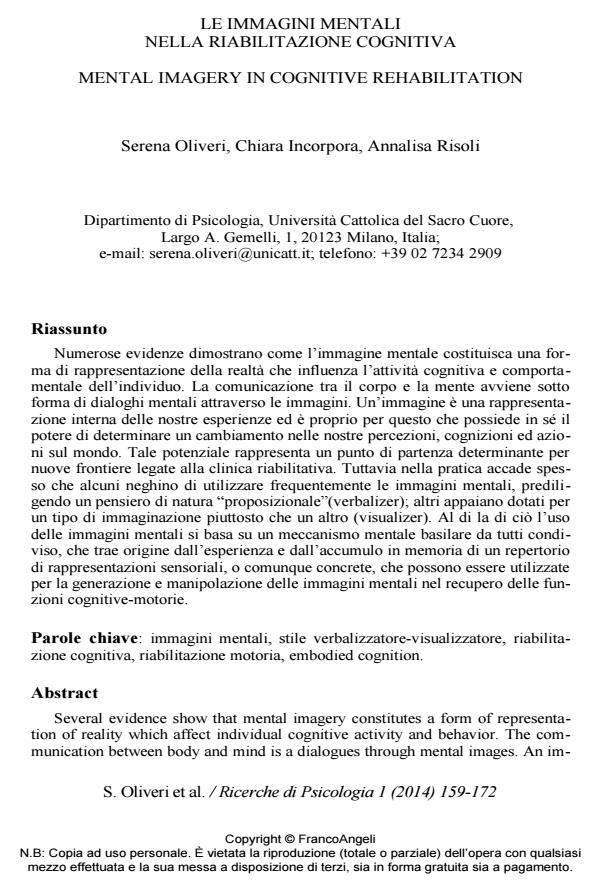Le immagini mentali nella riabilitazione cognitiva
Titolo Rivista RICERCHE DI PSICOLOGIA
Autori/Curatori Serena Oliveri, Chiara Incorpora, Annalisa Risoli
Anno di pubblicazione 2014 Fascicolo 2014/1
Lingua Italiano Numero pagine 14 P. 159-172 Dimensione file 170 KB
DOI 10.3280/RIP2014-001009
Il DOI è il codice a barre della proprietà intellettuale: per saperne di più
clicca qui
Qui sotto puoi vedere in anteprima la prima pagina di questo articolo.
Se questo articolo ti interessa, lo puoi acquistare (e scaricare in formato pdf) seguendo le facili indicazioni per acquistare il download credit. Acquista Download Credits per scaricare questo Articolo in formato PDF

FrancoAngeli è membro della Publishers International Linking Association, Inc (PILA)associazione indipendente e non profit per facilitare (attraverso i servizi tecnologici implementati da CrossRef.org) l’accesso degli studiosi ai contenuti digitali nelle pubblicazioni professionali e scientifiche
Numerose evidenze dimostrano come l’immagine mentale costituisca una forma di rappresentazione della realta che influenza l’attivita cognitiva e comportamentale dell’individuo. La comunicazione tra il corpo e la mente avviene sotto forma di dialoghi mentali attraverso le immagini. Un’immagine e una rappresentazione interna delle nostre esperienze ed e proprio per questo che possiede in se il potere di determinare un cambiamento nelle nostre percezioni, cognizioni ed azioni sul mondo. Tale potenziale rappresenta un punto di partenza determinante per nuove frontiere legate alla clinica riabilitativa. Tuttavia nella pratica accade spesso che alcuni neghino di utilizzare frequentemente le immagini mentali, prediligendo un pensiero di natura "proposizionale"(verbalizer); altri appaiano dotati per un tipo di immaginazione piuttosto che un altro (visualizer). Al di la di cio l’uso delle immagini mentali si basa su un meccanismo mentale basilare da tutti condiviso, che trae origine dall’esperienza e dall’accumulo in memoria di un repertorio di rappresentazioni sensoriali, o comunque concrete, che possono essere utilizzate per la generazione e manipolazione delle immagini mentali nel recupero delle funzioni cognitive-motorie.
Parole chiave:Immagini mentali, stile verbalizzatore-visualizzatore, riabilitazione cognitiva, riabilitazione motoria, embodied cognition.
Serena Oliveri, Chiara Incorpora, Annalisa Risoli, Le immagini mentali nella riabilitazione cognitiva in "RICERCHE DI PSICOLOGIA " 1/2014, pp 159-172, DOI: 10.3280/RIP2014-001009